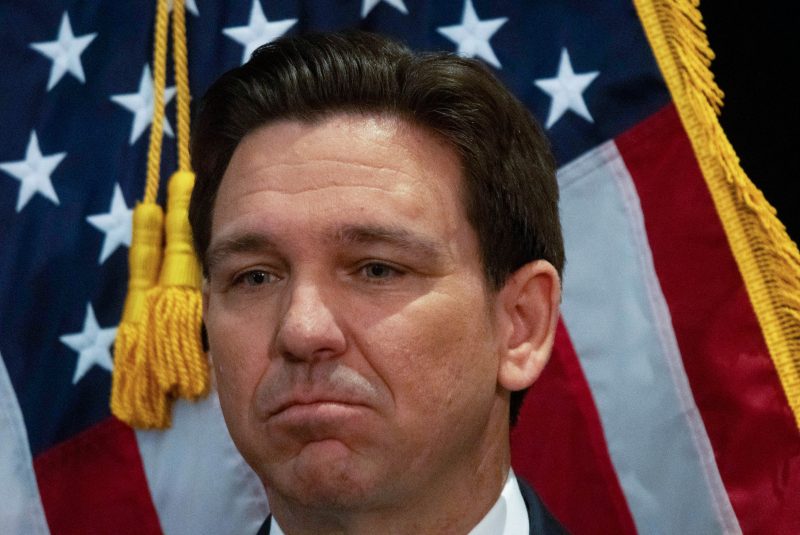Each of the participants in Thursday night’s blue-state-vs.-red-state debate on Fox News had an obvious reason for being there.
California Gov. Gavin Newsom (D), the blue-state guy, wanted to parlay his reported fixation with Fox News into an opportunity to speak directly to the network’s often misinformed viewers. Well, that and position himself as the natural representative of the political left, should Democrats in four years be looking to nominate someone for something.
Florida Gov. Ron DeSantis (R), the red-state guy, was there because it allowed him to debate a prominent Democrat — something he hoped to do next fall as his party’s nominee but that now seems unlikely. He, too, got to be the avatar for his party, a refreshing change from having to struggle for that title in a crowded primary field that includes folks with lower political profiles — such as Vivek Ramaswamy.
And then there was Sean Hannity, the debate’s moderator, to the extent that this term implying objectivity is appropriate. He got ratings and got to indulge the right’s pervasive idea that, if only they could debate the left, they would be proved unequivocally dominant.
That was not proved on Thursday night. No topic of discussion made that more obvious than the back-and-forth between Newsom and DeSantis on the coronavirus pandemic.
The subject was first broached by Newsom, which says something by itself. DeSantis’s appearance in the national spotlight centers on his response to the pandemic, that he reversed efforts to limit the spread of the virus before other states and then made an awful lot of noise about having done so. But, except for one debate during his reelection campaign last year, he has rarely had to defend his approach. Newsom intended to make him do so.
“You passed an emergency declaration before the state of California did,” Newsom said. He noted that DeSantis, joining other state leaders, had called for school and restaurant closures. “You were promoting vaccines,” Newsom said. “You even wore a mask.”
“You followed science,” he continued. “You followed Fauci” — referring to Anthony S. Fauci, the infectious-disease expert during the Donald Trump administration who called for such actions. DeSantis interrupted to disagree: “That’s not true.”
“He did all of that until he decided to fall prey to the fringe of his party,” Newsom charged. “And as a consequence of that, Ron, tens of thousands of people lost their lives.”
DeSantis objected, claiming that a “Lancet study” showed that “Florida had a lower standardized covid death rate than California did.” (Lancet publishes but does not conduct scientific research.)
Hannity jumped in to retake control of the debate. He had been planning to talk about the pandemic later, he said, but was happy to jump ahead. He showed a graphic indicating that Florida’s and California’s death rates per 100,000 residents were around 250, compared with 290 nationally.
“Both your states, with such different approaches, which is pretty fascinating, were both lower, significantly lower than the national average,” he said. “These numbers come straight from the [Centers for Disease Control and Prevention].” How, he asked, did Newsom explain that?
Newsom rejected the figures shown, arguing that California’s rate was lower than Florida’s. DeSantis insisted that Hannity’s graph proved his opponent wrong.
Hannity’s figures match the CDC’s estimates of covid-19 deaths adjusted for age since January 1, 2020. But those figures also fail to adequately consider how the pandemic evolved in each state.
Consider this chart of the cumulative death toll from the pandemic over time, adjusted for each state’s population.
Notice that vertical dotted line, showing the point at which 100 million doses of coronavirus vaccines had been administered. Before that point, the relative death toll in each state was fairly even. After that point, Florida’s numbers skyrocketed. About two-thirds of Florida’s deaths occurred after vaccines were widely available. Less than half of California’s did, even though the post-vaccine period made up more than two years.
Part of this was because of the emergence of the delta variant in summer 2021, which hit the Sun Belt particularly hard. But that is hardly exculpatory; if people had taken more precautions against the spread of the virus, if vaccinations had been more widespread, many of those deaths could have been prevented.
Instead, DeSantis was not only calling for closures to be rescinded at that point, he had pivoted to exhorting people to forgo preventive measures broadly.
What’s more, the surge wasn’t only because of delta. You can see below that covid-19 deaths per resident have been consistently higher in Florida than in California since vaccines became widely available.
In October 2022, research was published suggesting a correlation between death rates and politics. Analysis of covid-19 deaths and voter files in Florida and Ohio showed that Republicans were more likely than Democrats to die of covid after the introduction of vaccines.
That matched other data showing that more-Republican parts of the country had lower vaccination rates. The partisan gap on vaccination continues even now.
The implication is that partisanship played a role in informing whether people would be vaccinated and that, as a result, Republicans were more likely to die of covid-19. Research published recently indicates that the influence of partisan leaders against vaccination correlates to vaccine opposition.
The researchers compared the United States with Britain.
“Although conservative-leaning social networks on Twitter predicted vaccine hesitancy in the United States, this was not the case in [Britain] — where vaccine hesitancy was not as polarized,” they wrote. “These patterns suggest that the polarization of a pandemic is associated with the public stances of leaders and elites during the crisis.”
DeSantis was one such leader. His early promotion of vaccines became muted as he drew closer to announcing a bid for the 2024 Republican presidential nomination — seeking the approval of those voters who had been convinced that vaccination was somehow bad. In late 2021, he appointed a state surgeon general who has since become a prominent anti-vaccine voice.
All of that said, there is research — including a study published by Lancet — that suggests the death rates in California and Florida were comparable once you control for age, akin to the numbers Hannity showed. Older people have been more susceptible to covid-19 from the outset of the pandemic, and Florida has a much higher percentage of old people than California.
But this doesn’t account for the pre- and post-vaccine divide. In 2021, age-adjusted CDC data suggests that Florida’s death rate was 12 percent higher than California’s. By April 1, 2021, 80 percent of Florida seniors had been vaccinated; by July 1, it was at 92 percent. Yet Florida still saw far more deaths after the vaccines were widely available than before.
DeSantis attempted to rebut Newsom’s charges by pointing to California’s higher excess-death rates, a measure of how many deaths were reported in states relative to estimates based on previous years. The Florida governor’s implication was that the restrictions California kept in place for longer had downstream effects that hurt Californians.
Looking at CDC data showing how the number of reported deaths each week exceeded expectations, we do see that California tracks more closely with Florida in the post-vaccination era. But, of course, most of the restrictions that existed were lifted by the end of 2021.
The excess-death figures also include covid-19 deaths (since those deaths were not anticipated based on historic death totals). If we separate out only excess deaths not linked to covid-19, the effect is more modest, with California seeing higher rates than Florida in late- 2020.
In the second half of 2020, California had about 9,700 non-covid-linked excess deaths. Florida had about 5,100. That’s 25 per 100,000 California residents and 23 per 100,000 Floridians.
DeSantis for years has centered his political persona on his response to the coronavirus pandemic. It’s one of the reasons his 2024 bid isn’t going that well; the issue simply isn’t as salient as it was in 2021. In part, because the urgency of the question has faded, he hasn’t often been put in a position where he needs to defend his record.
On Thursday, he did. You may judge the results for yourself.
This article has been updated to include the source of Hannity’s covid-19 data.


































